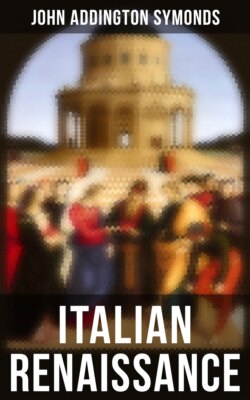Читать книгу Italian Renaissance - John Addington Symonds - Страница 45
На сайте Литреса книга снята с продажи.
PREFACE[1]
ОглавлениеTable of Contents
This volume on the 'Revival of Learning' follows that on the 'Age of the Despots,' published in 1875, and precedes that on the 'Fine Arts,' which is now also offered to the public. In dealing with the 'Revival of Learning' and the 'Fine Arts,' I have tried to remember that I had not so much to write again the history of these subjects, as to treat their relation to the 'Renaissance in Italy.' In other words, I have regarded each section of my theme as subordinate to the general culture of a great historical period. The volume on 'Italian Literature,' still in contemplation, is intended to complete the work.
While handling the theme of the Italian Renaissance, I have selected such points, and emphasised such details, as I felt to be important for the biography of a nation at the most brilliant epoch of its intellectual activity. The historian of culture sacrifices much that the historian of politics will judge essential, and calls attention to matters that the general reader may sometimes find superfluous. He must submit to bear the reproach of having done at once too little and too much. He must be content to traverse at one time well-worn ground, and at another to engage in dry or abstruse inquiries. He must not shrink from seeming to affect the fame of a compiler; nor, unless his powers be of the highest, can he hope altogether to avoid repetitions wearisome alike to reader and to writer. His main object is to paint the portrait of national genius identical through all varieties of manifestation; and in proportion as he has preserved this point of view with firmness, he may hope to have succeeded.
For the History of the Revival of Learning I have had continual recourse to Tiraboschi's 'Storia della Letteratura Italiana.' That work is still the basis of all researches bearing on the subject. I owe besides particular obligations to Vespasiano's 'Vite di Uomini Illustri,' to Comparetti's 'Virgilio nel Medio Evo,' to Rosmini's 'Vita di Filelfo,' 'Vita di Vittorino da Feltre,' and 'Vita di Guarino da Verona,' to Shepherd's 'Life of Poggio Bracciolini,' to Dennistoun's 'Dukes of Urbino,' to Schultze's 'Gemistos Plethon,' to Didot's 'Alde Manuce,' to Von Reumont's 'Lorenzo de' Medici,' to Burckhardt's 'Cultur der Renaissance in Italien,' to Voigt's 'Wiederbelebung des classischen Alterthums,' and to Gregorovius's 'Geschichte der Stadt Rom.' To Voigt and Burckhardt, having perforce traversed the same ground that they have done, I feel that I have been in a special sense indebted. At the same time I have made it my invariable practice, as the notes to this volume will show, to found my own opinions on the study of original sources. To mention in detail all the editions of the works of humanists and scholars I have consulted, would be superfluous.
To me it has been a labour of love to record even the bare names of those Italian worthies who recovered for us in the fourteenth and fifteenth centuries 'the everlasting consolations' of the Greek and Latin classics. The thought that I was tracing the history of an achievement fruitful of the weightiest results for modern civilisation has sustained me in a task that has been sometimes tedious. The collective greatness of the Revival has reconciled my mind to many trivialities of detail. The prosaic minutiæ of obscure biographies and long-forgotten literary labours have been glorified by what appears to me the poetry and the romance of the whole theme. It lies not in my province or my power to offer my readers any adequate apology for such defects as my own want of skill in exposition, or the difficulty of transfiguring with vital light and heat a subject so remote from present interests, may have occasioned. I must leave this volume in their hands, hoping that some at least may be animated by the same feeling of gratitude toward those past workers in the field of learning which has supported me.
Clifton:
March 1877.
